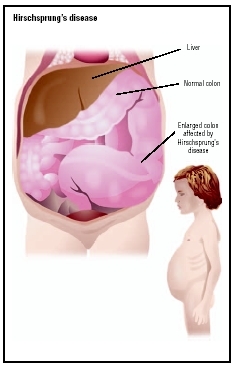
Hirschsprung’s Disease is a congenital disorder of the large intestine that occurs in about one in five thousand births. Unfortunately, this disease is responsible for twenty-five percent of all intestinal blockages in newborns. Suspected signs and symptoms in a newborn include constipation, abdominal distension, projectile vomiting, poor feeding, and a failure to pass meconium within forty-eight hours after birth. Physiologically, the affected segment of the large intestine narrows because of the absence of local ganglion nerve cells which function to prevent bowel contraction. In long segment HD, more of the large intestine is affected (than in short segment HD) with as much as thirty centimeters of the bowel contracted. Although the affected area of the large intestine is contracted, the preceding area of the large intestine is enlarged due to the backup of bowel contents which is why patients present with a distended abdomen.
Pediatricians and pediatric gastroenterologists report that normal breast-fed newborns have approximately four to five bowel movements a day and formula fed newborns will have two to three bowel movements a day. In Hirchsprung’s patients, the number of bowel movements is significantly diminished as a result of the constipation caused by the narrowing of the bowel. At six months of age, most normal newborns have two bowel movements per day; however, this number is typically less for Hirschsprung’s patients of the same age.
Without proper diagnosis and treatment, Hirschsprung’s patients are at risk for intestinal rupture or perforation that can cause death. Methods of diagnosis include a rectal suction biopsy, or a full thickness biopsy which is generally definitive. Other techniques that may indicate the presence of Hirchsprung’s disease include anorectal manometry and barium enema. There are various surgical techniques available to treat severe Hirschsprung’s disease. Corrective surgery to the large intestine is performed in two phases. The first phase involves a colostomy and is usually performed early in life. Years later, the second surgical phase is performed which is a pull-through procedure where the large intestine is reconnected to the anus. There are several different types of pull-through procedures that are well established, with the transanal pull-through procedure gaining popularity. High fiber diets and frequent enemas help to alleviate symptoms of constipation associated with Hirschsprung’s disease.
Medical malpractice may arise when there is a failure to diagnose Hirschsprung’s disease that results in death or serious permanent injury. Allegations may include a failure to timely refer the patient to a pediatric gastroenterologist or surgeon, or a failure to order or perform proper diagnostic testing or biopsy.
For a complete overview on the diagnosis and treatment of Hirschsprung’s disease, please see the 3rd edition of Hirschsprung’s Disease and Allied Disorders by A.M Holschneider and P. Puri which became available in paperback in 2010. For families who have a loved one afflicted with Hirschsprung’s disease, there is a support group called the Hirschsprungs & Motility Disorders Support Network .
